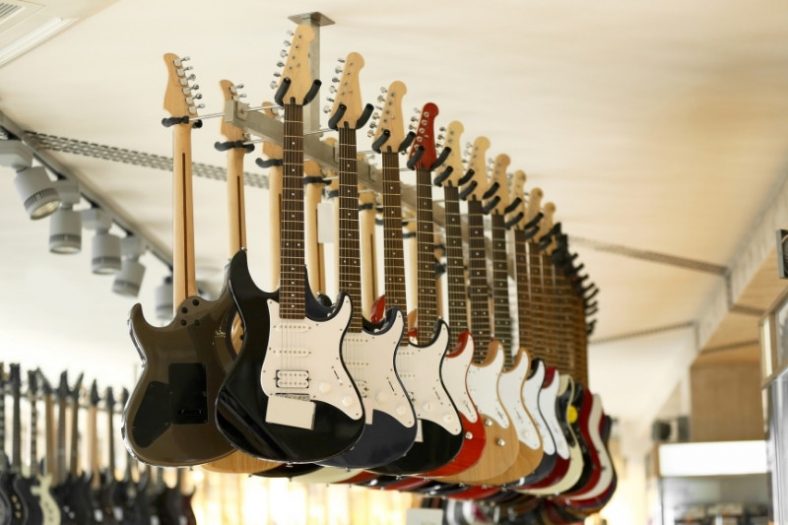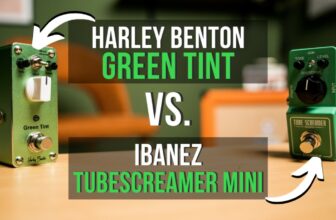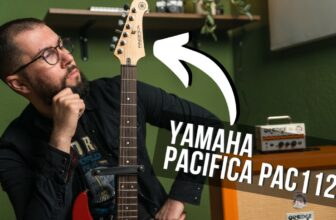Bolt-On vs Set Neck vs Neck Through Guitars

There are three main types of guitar neck joints: bolt-on necks, set necks, and neck-through necks. Bolt-on necks are screwed to the guitar body, set necks are glued to the guitar body like a piece of a puzzle, and neck-through necks are made of the same piece of wood used in the guitar body.
Comprehending the difference between these three types of guitar neck joints is important, especially when buying a new guitar. Different neck joints can have a slight influence on how a guitar sounds and a huge impact on a guitar’s durability, cost, and maintenance.
Even though the neck joint isn’t the most important guitar part there is, it’s still a fundamental component of the instrument. Guitar-neck construction can change the tone of a guitar because it affects the behavior of the guitar strings. It can also influence the comfort level of guitarists.
Contents
Bolt-On vs Set Neck vs Neck Through Guitars
Generally, a guitar will be more expensive depending on how thoroughly attached the neck joint is to the guitar body. There are many types of acoustic and electric guitars out there, but the rule of thumb is that bolt-on necks are more affordable while set necks and neck-through necks are more high-priced.
Does this mean that set necks and neck-through necks are better than bolt-on necks? Not necessarily. More than a matter of budget, choosing which neck joint suits a guitarist the best is about analyzing the specific needs and preferences of such a guitarist.
If you like a sharper tone and want to be able to quickly and cheaply replace your guitar’s neck joint, then you should opt for a bolt-on neck. If you favor a guitar with a warm, fuller sound, then you should choose a set neck. If you want a guitar with high-quality resonance and sustain that will last your a lifetime, a neck-through neck is the most fitting option.
This should cover the basics, but there’s more to guitar neck joints. To fully understand the differences between these three types of necks, it’s important to dive into the main characteristics, pros, and cons of each one.
What is a Bolt-On Neck?
Bolt-on necks are easy to manufacture and the most common type of guitar neck joint. You can identify a guitar with a bolt-on neck by checking for screws on the back of the instrument. Most bolt-on necks are attached to the body using four screws, but some guitars have just two.
Contrary to set necks and neck-through necks, bolt-on necks can be easily replaced. All you have to do is buy a new bolt-on neck, unscrew the old one, and attach the new neck to the body. Manufacturers love bolt-on necks because using them means they can produce the guitar body and neck separately.
Because the screws create a slight gap between the body and the neck of the guitar, guitars with bolt-on necks have a sharper tone with a slow sustain and response. Overall, they sound brighter than guitars with set necks and neck-through necks.
Pros and Cons of Bolt-On Necks
Pros
- Easy to replace
- Easy to manufacture
- Brighter sound with a long sustain
Cons
- Not as resistant as the alternatives
- Sustain control isn’t as precise
- They can be uncomfortable, depending on the model
What is a Set Neck?
Set necks are made to fit into the body of the guitar like a piece of a puzzle and attached using very strong wood glue. You can identify a guitar with a set neck joint by looking for a smooth point of transition between the neck and the body. Set neck joints are favored by many of the best electric guitar brands in the world.
Even though guitars with set neck joints aren’t as durable as guitars with neck-through neck joints, they’re as hard to repair. If a set neck breaks, it’s virtually impossible to replace it with a new one. The only solution is to buy a new guitar altogether. Nonetheless, set-neck guitars don’t break easily and are extremely resistant.
In terms of sound, set-neck guitars are perfect for guitarists looking for a lush tone with warm low to low-mid frequencies and high-quality resonance. Because there’s a better tonal transfer between the body and the neck, set-neck guitars sound fuller (but less sharp) than guitars with a bolt-on neck.
Pros and Cons of Set Necks
Pros
- A warm, lush, and full tone
- A standard among high-end manufacturers
- Aesthetically pleasing
Cons
- Virtually impossible to repair
- More costly than bolt-on necks
- The glue can wear off over time
What is a Neck Through?
Neck-through necks are made with the same piece of wood that’s used in the body of the guitar. This means that neck-through necks can be described as an extension of the guitar body. To identify a guitar with a neck-through neck, inspect the neck to see if it ends at the very bottom of the guitar body, with no gaps or points of transition.
Neck-through necks are favored by metal guitarists because they are extremely durable and able to offer a high level of stability. Guitar manufacturers often combine different types of wood to create extremely stable, quasi-unmovable, neck-through necks.
Out of all the types of guitar neck joints, neck-through necks are the ones that vibrate less. For this reason, they have a less full but more precise tone. Because they offer a lot of control over resonance, guitars with a neck-through neck are ideal for shredding and favored by highly-technical guitarists.
Pros and Cons of Neck Throughs
Pros
- Excellent sustain control
- Extremely durable and stable
- Very comfortable
Cons
- More expensive to manufacture
- The neck can’t be replaced
- Not ideal for playing lush, warm chords
Conclusion
Choosing the best guitar neck joint isn’t as black-and-white as it seems. It’s all up to what kind of guitar tone you like and what you expect to get from your next guitar.
Even though guitar neck joints are important, nothing influences the sound of a guitar like the talent of the guitarist. Regardless of what the neck joint of your guitar looks like, the most important thing is to continue to improve your guitar playing.





